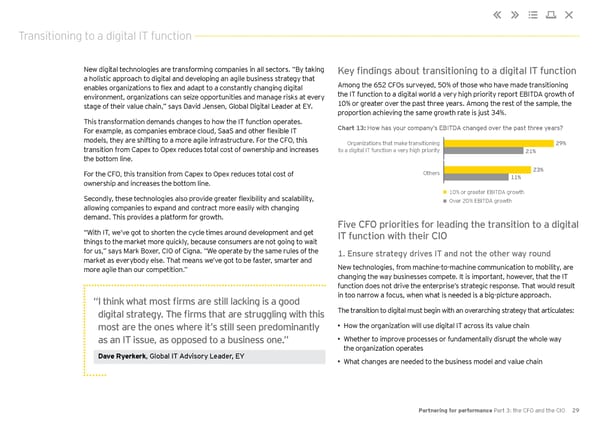Transitioning to a digital IT function New digital technologies are transforming companies in all sectors. “By taking Key findings about transitioning to a digital IT function a holistic approach to digital and developing an agile business strategy that Among the 652 CFOs surveyed, 50% of those who have made transitioning enables organizations to flex and adapt to a constantly changing digital the IT function to a digital world a very high priority report EBITDA growth of environment, organizations can seize opportunities and manage risks at every 10% or greater over the past three years. Among the rest of the sample, the stage of their value chain,” says David Jensen, Global Digital Leader at EY. proportion achieving the same growth rate is just 34%. This transformation demands changes to how the IT function operates. Chart 13: How has your company’s EBITDA changed over the past three years? For example, as companies embrace cloud, SaaS and other flexible IT models, they are shifting to a more agile infrastructure. For the CFO, this Organizations that make transitioning 29% transition from Capex to Opex reduces total cost of ownership and increases to a digital IT function a very high priority 21% the bottom line. For the CFO, this transition from Capex to Opex reduces total cost of Others 23% ownership and increases the bottom line. 11% Secondly, these technologies also provide greater flexibility and scalability, 10% or greater EBITDA growth Over 20% EBITDA growth allowing companies to expand and contract more easily with changing demand. This provides a platform for growth. Five CFO priorities for leading the transition to a digital “With IT, we’ve got to shorten the cycle times around development and get IT function with their CIO things to the market more quickly, because consumers are not going to wait for us,” says Mark Boxer, CIO of Cigna. “We operate by the same rules of the 1. Ensure strategy drives IT and not the other way round market as everybody else. That means we’ve got to be faster, smarter and more agile than our competition.” New technologies, from machine-to-machine communication to mobility, are changing the way businesses compete. It is important, however, that the IT function does not drive the enterprise’s strategic response. That would result “ I think what most firms are still lacking is a good in too narrow a focus, when what is needed is a big-picture approach. digital strategy. The firms that are struggling with this The transition to digital must begin with an overarching strategy that articulates: most are the ones where it’s still seen predominantly • How the organization will use digital IT across its value chain as an IT issue, as opposed to a business one.” • Whether to improve processes or fundamentally disrupt the whole way the organization operates Dave Ryerkerk, Global IT Advisory Leader, EY • What changes are needed to the business model and value chain Partnering for performance Part 3: the CFO and the CIO 29
 Partnering for Performance Part 3 Page 28 Page 30
Partnering for Performance Part 3 Page 28 Page 30